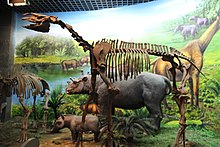Juxia
| Juxia Temporal range:
| |
|---|---|

| |
| Mounted skeleton, Inner Mongolia Museum | |
| Scientific classification | |
| Domain: | Eukaryota |
| Kingdom: | Animalia |
| Phylum: | Chordata |
| Class: | Mammalia |
| Order: | Perissodactyla |
| Suborder: | Ceratomorpha |
| Superfamily: | Rhinocerotoidea |
| Family: | †Paraceratheriidae |
| Genus: | †Juxia Chow & Chiu, 1964 |
| Type species | |
| †Juxia sharamurenensis Chow & Chiu, 1964
| |
| Species | |
| |
| Synonyms[3][4] | |
Species synonyms
| |
Juxia, ‘joo-she-a’, (from Chinese: 巨犀; pinyin: Jùxī; lit. 'gigantic rhinoceros') is an extinct genus of paraceratheriid, a group of herbivorous mammals that are related to the modern rhinoceros. The type species is Juxia sharamurenensis, named by Zhou Mingzhen and Qiu Zhanxiang in 1964. Juxia was around the size of a horse. It lived in Asia during the upper Eocene.[1]

As an early indricothere, Juxia was a relatively small compared to its later relatives, with a body mass estimated at 749–888 kilograms (1,651–1,958 lb) or 1,482 kilograms (3,267 lb),[5] held by elongated long legs and small skull firmly attached to a relatively long neck. Based on its triangular like teeth and sharp protruding incisors, Juxia was probably a strict browser, feeding on ferns and leaves on branches where most herbivorous mammals could not reach. In terms of habitat, Juxia lived in densely lush and tropical forests of what is now China. Though a few skeletons have been found, it is unclear whether this early indricothere was permanently solitary or lived in small social groups, possibly harems. Based on its morphology, Juxia's long legs probably enabled it to run relatively fast for a limited duration. This was probably a defense mechanism against early mammalian predators.[6]
References
[edit]- ^ a b Chow, M.-C.; Chiu, C.-S. (1964). "An Eocene giant rhinoceros". Vertebrata PalAsiatica (in Chinese (China) and English). 8 (3): 264–267.
- ^ Qi, T.; Zhou, M. (1989). "A new species of Juxia (Perissodactyla), Nei Mongol" (PDF). Vertebrata PalAsiatica (in Chinese (China) and English). 27 (3): 205–208.
- ^ Lucas, S.G.; Sobus, J.C. (1989). "The Systematics of Indricotheres". In Prothero, David R.; Schoch, Robert M. (eds.). The Evolution of Perissodactyls. Oxford University Press. pp. 358–378. ISBN 978-0-19-506039-3. OCLC 19268080.
- ^ Qiu, Z.; Wang, B. (2007). "Juxia Chow et Chiu ( = Zhou et Qiu), 1964". Paracerathere Fossils of China (in Chinese (China) and English). Vol. 29. Beijing: Science Press. pp. 15–100. ISBN 978-7-03-019127-4.
{{cite book}}:|journal=ignored (help) - ^ Li, Shijie; Jiangzuo, Qigao; Deng, Tao (2022-07-06). "Body mass of the giant rhinos (Paraceratheriinae, Mammalia) and its tendency in evolution". Historical Biology: 1–12. doi:10.1080/08912963.2022.2095908. ISSN 0891-2963.
- ^ Prothero, D. (2013). Rhinoceros Giants: The Palaeobiology of Indricotheres. Indiana: Indiana University Press. ISBN 978-0-253-00819-0.









